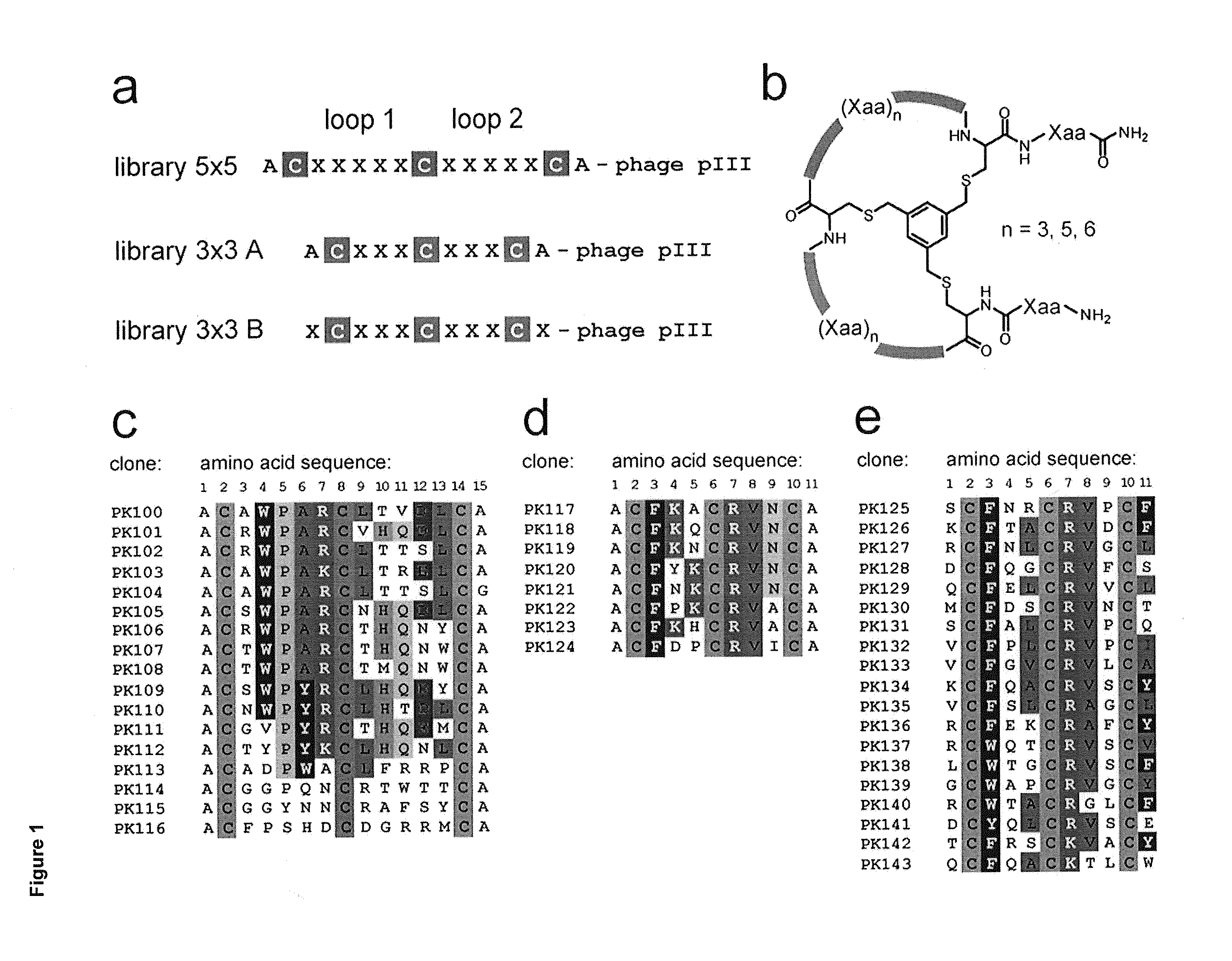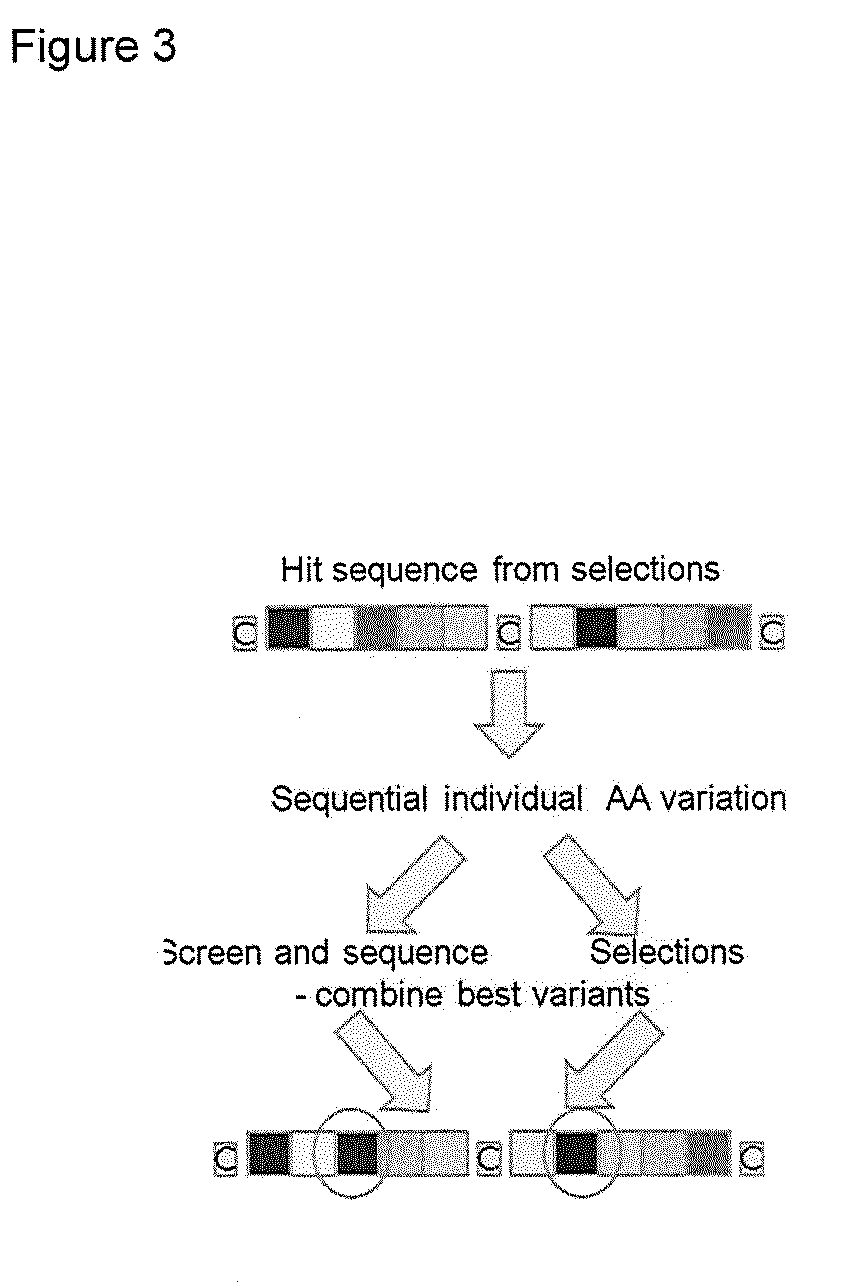Modulation of structured polypeptide specificity
a polypeptide specificity and structure technology, applied in the field of polypeptides, can solve the problems of reducing the conformational flexibility of the cyclic structure, and achieve the effect of increasing the protease resistance of the polypeptid
- Summary
- Abstract
- Description
- Claims
- Application Information
AI Technical Summary
Benefits of technology
Problems solved by technology
Method used
Image
Examples
example 1
Identification of Preferred Residues for Binding Activity
[0239]From the examples of 5×5 peptides shown in Table 4 it is possible to identify amino acids that are conserved between peptides with binding activity. To determine which residues were preferred for binding activity, representatives from two of the identified families of peptides were studied further. These were peptides 06-34, which comprises a CXWPARC motif in the first loop of the bicycle, and peptide 06-56, which comprises a CGGxxNCR motif across both loops of the bicycle. For each peptide sequence, a set of 10 phage libraries was created in which 9 of the loop residues were kept constant and the other residue was randomised so that any amino-acid could be expressed in the library at that position. (See ‘Randomisation of individual positions—Library construction’ in Methods above.) For each library a set of 20 randomly selected phage clones were screened for binding to human Kallikrein in a phage binding assay to identi...
example 2
Detailed Analysis of WPAR Domain
[0247]The WPAR motif identified from Example 1 was analysed in the context of the 06-34-03 peptide, in order to identify alternatives or improvements to the WPAR motif. A library was constructed where positions 1, 6, 7, 8, 9 &10 of 06-34-03 were fixed and positions 2, 3, 4 & 5 were randomised (see ‘Randomisation of peptide domains—Library construction’ in Methods above). Selections against human plasma Kallikrein were performed at a variety of stringencies (see Phage selections' in Methods above). All output sequences were identified and analysed for target binding (see ‘Randomisation of peptide domains—Assay of binding of individual clones’ in Methods above). Table 17 lists each unique sequence, its relative abundance in the selection output (frequency), and a rank number according to target binding strength.
[0248]Table 17 shows that WPAR motif confers the best binding to human plasma Kallikrein, although other Kallikrein binding sequences are retrie...
example 3
Optimisation of Sequence Outside WPAR
[0250]The WPAR motif and its variants have been studied within the context of peptide 06-34-03. FIG. 1 demonstrates that some positions outside of the WPAR motif can maintain Kallikrein binding when substituted for other residues. In order to study the non-WPAR determinants of Kallikrein binding, a phage library was generated with a fixed-WPAR sequence and all other positions randomised (CxWPARCxxxxxC) as described in ‘Randomisation of peptide domains—Library construction’ in Methods above.
[0251]80 random library members were isolated directly from the library pool (no selection) and assayed for binding to Kallikrein at both high and low stringency (see ‘Randomisation of peptide domains—Assay of binding of individual clones’ in Methods above). These library members, which contain random sequences outside the WPAR, showed little or no binding to human plasma Kallikrein (data not shown), indicating that the presence of a WPAR motif alone is not suf...
PUM
| Property | Measurement | Unit |
|---|---|---|
| half life | aaaaa | aaaaa |
| weight | aaaaa | aaaaa |
| pH | aaaaa | aaaaa |
Abstract
Description
Claims
Application Information
 Login to View More
Login to View More - R&D
- Intellectual Property
- Life Sciences
- Materials
- Tech Scout
- Unparalleled Data Quality
- Higher Quality Content
- 60% Fewer Hallucinations
Browse by: Latest US Patents, China's latest patents, Technical Efficacy Thesaurus, Application Domain, Technology Topic, Popular Technical Reports.
© 2025 PatSnap. All rights reserved.Legal|Privacy policy|Modern Slavery Act Transparency Statement|Sitemap|About US| Contact US: help@patsnap.com



